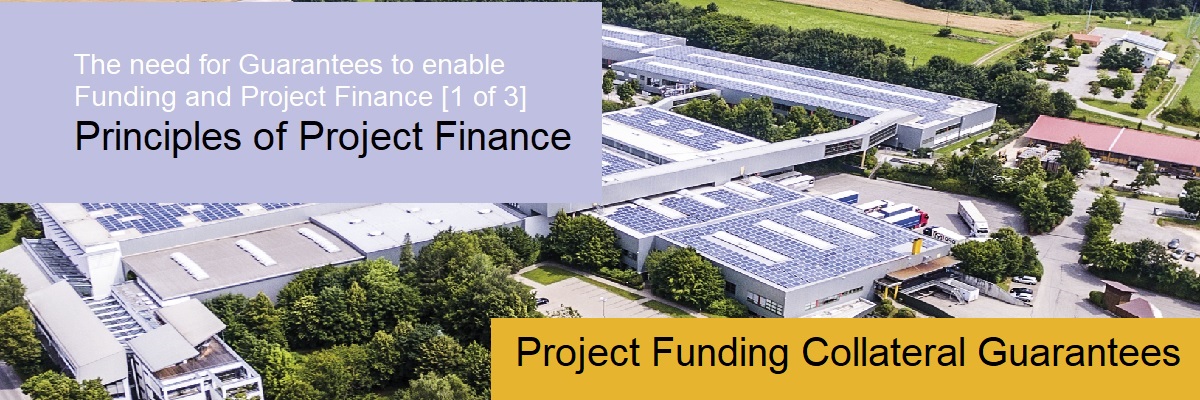
The need for Guarantees to enable Funding and Project Finance. Project finance is a method of raising long-term debt financing for major projects through ‘financial engineering’. It is based on lending against the cash flow generated by the project alone. Project finance depends on a detailed evaluation of a project’s construction, operating and revenue risks, and their allocation between investors, lenders, and other parties through contractual and other arrangements.
The writer is experienced, both as a banker and as an independent advisor in project finance. If you need guidance to the principles of project finance and to the practical issues that can cause the most difficulty in commercial and financial negotiations, then you should read on.
This report can serve as a structured introduction for those who are new to the subject, and as guidance for those developing and negotiating project-finance transactions. To fully understand the subject of this report, no prior knowledge of the financial markets or financial terms is assumed or required.
The report is structured based on reviews the basic features of project finance, the factors behind its development, and the ‘building blocks’ of a project-finance structure. The benefits of using project finance are considered from the point of view of the various project participants.
Project Development and Management
The life of a project can be divided into three phases: development, construction, and operation. The Sponsors play the primary role during the development phase of the project, managing this process with the support of external advisors. Where more than one Sponsor is involved, a joint-venture structure has to be agreed to. The Project Company is usually set up towards the end of the development phase and manages the project from Financial Close. The project may also be developed initially by parties other than the Sponsors through a bidding or public procurement process for a PPP project, organized by a Contracting Authority.
The Project-Finance Markets
Private-sector project-finance debt has traditionally been mainly provided from two sources—commercial banks and bonds. Commercial banks provide long-term loans to Project Companies; bondholders (typically life-insurance companies and pension funds, which need long-term cash flows) purchase long-term bonds (tradable debt instruments) issued by Project Companies. Recently these non-bank lenders have also begun to make direct loans to projects and participate in debt funds. Other types of private-sector finance are sometimes also used in projects. Although the financial and legal structures and procedures are different, the criteria under which debt is raised in each of these markets are much the same.
Working with Lenders
Considered are the procedures for raising project finance from private-sector lenders, in particular commercial banks and bondholders, with a comparison between the two. Lenders’ ‘due diligence’ processes, and the roles of their various external advisors also have the be considered as well as the ways in which a Contracting Authority interacts with bidders’ lenders in a public-procurement process.
Types of Project Agreement
The Project Contracts provide a basis for the Project Company’s construction and operation of the project. The most important of these is the Project Agreement which is the contract that provides the framework under which the Project Company obtains its revenues. The Sub-Contracts which make up the rest of the Project Contracts are important as well and have to be considered and discussed like the Offtake Contract, Availability-based Contract and Concession Agreement.
A preliminary clarification: expressions such as BOT, DBFO, and so on are rather confusing, and overlap with each other. There is actually no need to use these terms. There are three main models for a Project Agreement: (1) an Offtake Contract in a process-plant project, under which the Project Company produces a product and sells it to an Offtaker. (2) an Availability-based Contract based on the PFI Model where a Contracting Authority pays a Project Company for making the project available for use. (3) A Concession Agreement, under which the Project Company provides a public service, and collects User Charges for doing so. The confusing list of ‘PPP-like’ contracts, which are often counted as PPPs, but most of which do not require project finance should also provide interesting, related information for this subject.
We prefer to work with qualified clients with good banking relation to leverage a client’s financial possibilities for project finance. Chances to materialize a transaction can be very high if the borrower’s company is of substance. If you would like to discuss this further, please use the reply form, or call 00353860325153. This number also works on Whatsapp, Signal, Telegram and WeChat.
|
Learn more about these topics by reading our blog post “The need for Guarantees to enable Funding and Project Finance” 2 and 3
· Common Aspects of Project Agreements · Sub-Contracts and Other Related Agreements · Commercial Risks · Macro-Economic Risks · Regulatory and Political Risks · Financial Structuring · The Financial Model · Project-Finance Loan Documentation · Public-Sector Financial Support · Export-Credit Agencies and Development-Finance Institutions · Recent Market Developments and Prospects for Project Finance
NOTE: The content of this report is an abstract based on the 577-page book we make available to our contracted clients providing guideline to successfully structure project finance with the help of third-party collateral and Prime Bank Guarantees. It is widely read by private sector investors and lenders who intend to make project finance deals.
|

Funding African Trading Transactions

The Power of a Loan Agreement

A helpful Strategy to attract Investors

How a Loan Agreement can attract investors.

Proof to be eligible to borrow funds

How to benefit from a Loan Agreement if you don’t have collateral.

How to benefit from a Loan Agreement asking for collateral.

How a Loan Agreement can get you in funds.

Why should a client provide a Mandate and place a retainer to get a bank instrument and credit enhancement service?
Not satisfied with the results of your own Project Funding activities?

